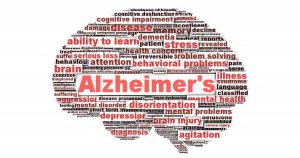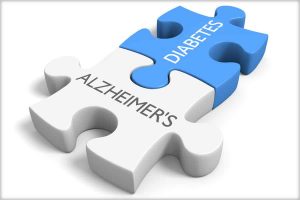
Alzheimer’s Disease:
Alzheimer’s Disease (AD) is the most common type of dementia and is characterized by memory loss and loss of other cognitive abilities that interfere with everyday life. The majority of individuals with Alzheimer’s Disease are greater than 65 years of age, however, some individuals who acquire the disease at a younger age are diagnosed with early-onset Alzheimer’s Disease. AD is a progressive, neurodegenerative disease that worsens over time and is the sixth leading cause of death in the United States. The disease also has a spectrum of severity, where in its mild stage, it will just beginning to affect a person’s functions and in its most severe stage, a person can depend completely on others for aid in their basic activities of daily living. There is no known cause of Alzheimer’s, however there are many aspects that can play into the overall diagnosis and symptoms of Alzheimer’s, including genetic, environmental, and lifestyle. One of these possible causes is that Alzheimer’s is passed through genetics. If a family member has been diagnosed with Alzheimer’s Disease, there is a slightly greater risk that an individual older than 65 will develop Alzheimer’s. However, if an individual is younger than 65, there is a much greater risk of developing AD. Another major aspect of the cause of AD is the role of plaques and tangles in the brain. Plaques are deposits of beta-amyloid protein fragments that build up in spaces between nerve cells and tangles are twisted fibers of tau that build up inside cells. Both of these abnormal structures play a role in the destruction of nerve cells. AD brains show build-ups of these structures, especially in areas of the brain crucial for memory. Plaques and tangles are thought to play a role in blocking nerve cell communication and disrupting cell processes. The death of nerve cells is what causes memory failure and cognitive issues. In the case of genetics, there has been one gene that has been found to be involved in late-onset Alzheimer’s, and that is the apolipoprotein E gene. Typically, if a person carries this gene, they will have a greater risk of developing the disease. Another connection is that the majority of people diagnosed with Down syndrome will develop Alzheimer’s disease. There are many symptoms that may be signs of AD, but the most common include difficulty remembering information, memory loss, confusion, disorientation, mood and behavior changes, losing pleasure in activities, difficulty speaking or swallowing, and muscular difficulties. Since the only way to truly tell if a person has AD is to observe abnormalities in their brain tissue, AD can only be fully diagnosed after death when the brain can be examined in an autopsy. The changes in the brain often begin to occur about a decade before symptoms begin to show. To diagnose Alzheimer’s, doctors will look at health and family records, conduct tests of memory, language, and problem solving, carry out medical tests, and perform brain scans to rule out other causes of symptoms. Since there is no current cure for AD, survival after diagnosis can range from four to twenty years. Current treatments focus on managing the symptoms, which can overall help to slow the progression of the disease. This can include various medications to treat symptoms by managing neurotransmitter release, managing behavior such as agitation or anxiety, and various types of therapies.

Type II Diabetes:
Type II Diabetes is the most common form of diabetes and occurs when the body does not use insulin properly, which is insulin resistance. This can also occur when the body does not produce enough insulin. Insulin comes from the pancreas and is circulated into the bloodstream to allow glucose to enter the cells. Insulin also lowers sugar levels in the bloodstream. In Type II diabetes, the pancreas cannot keep up with the deficient insulin productions and blood glucose levels start to fluctuate. The glucose starts to build up in the blood and causes cells to lose energy and affect your kidneys, nerves, and heart. Some people can control their Type II diabetes, but typically the disease worsens over time. There are many risk factors of Type II diabetes, including weight, inactivity, family history, age, and others. Some symptoms of Type II diabetes include increased thirst and frequent urination, increased hunger, weight loss, fatigue, blurred vision, frequent infections, or areas of darkened skin. Symptoms vary person to person, but any of these symptoms can be a sign to see a doctor. To be diagnosed, doctors will run a blood test to measure your blood glucose levels. There is no cure for this disease, however Type II Diabetes is typically treated with lifestyle changes, oral medications, and insulin injections.

The Connection Between Diabetes and Alzheimer’s:
Insulin Signaling:
Insulin resistance is a characteristic of Type II diabetes and has been proven to be a common mechanism connecting diabetes and AD. This can be caused by oligomers of the ABOs, which causes insulin insensitivity and the removals of insulin receptors. The insulin signaling pathway is impaired in AD brains and as neurons become degraded, there is less insulin in the brain, causing impaired cognitive function. Insulin receptors are distributed in the brain and when insulin reaches the brain, it is synthesized by pancreatic beta-cells. Insulin is supposedly neuroprotective and helps with neuronal survival, however in Alzheimer’s, as neurons are being destroyed, there is not enough insulin to protect the neurons from the plaques and tangles. By boosting insulin signaling with drugs or therapies, this neurodegeneration can be slowed and neurons and pathways can be protected. Both diseases cause insulin resistance.
Inflammation:
In Type II diabetes, insulin resistance often exhibits itself as inflammation, mediated by macrophages. AD also presents with an inflammatory state, mediated by microglia. Activation and secretion of cytokines occur by microglia and cause an inflammatory reaction in AD. By sustained inflammation acting as a trigger, insulin resistance in AD occurs and leads to insulin resistance in diabetes.
Gangliosides:
A ganglioside is a group of lipids present in the gray matter of the brain. In diabetes, ganglioside GM3 is the mediator of insulin resistance. Without GM3, there is enhanced insulin sensitivity. Ganglioside GM1 is involved in the development of insulin receptors. Gangliosides are also known to have a role in the pathogenesis of AD, showing that gangliosides are a factor of causing insulin resistance in both diabetes and AD. The dysregulation of gangliosides causes insulin issues in both diseases. Diabetes causes an increase in the development of plaques and amyloid deposition, both characteristics of AD.
These are just three of the many different ways Alzheimer’s disease is connected to Type II diabetes. By finding the connections between the two diseases, there may be more opportunities for treatments, therapies, and hopefully someday a cure. The impact of both diseases on a individual and an individual’s family can have great impacts on not only their personal life, but also the lives surrounding them. To increase a person’s quality of life, it is important that scientists continue the search for connections of both diseases to the factors that are impacting them.
https://www.alz.org/alzheimers-dementia/what-is-alzheimers
https://www.nia.nih.gov/health/alzheimers-disease-fact-sheet
http://www.diabetes.org/diabetes-basics/type-2/facts-about-type-2.html
https://www.mayoclinic.org/diseases-conditions/type-2-diabetes/symptoms-causes/syc-20351193
https://www.webmd.com/diabetes/type-2-diabetes#2